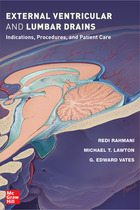Non ci sono recensioni
DA SCONTARE
The most common point of contact with providers in neurocritical care units, trauma units, and emergency departments, external ventricular drains and lumbar drains are used to relieve elevated intracranial pressure, usually due to a brain hemorrhage from acute trauma.
Covering indications, anatomy, planning, and procedure stages for each drain, External Ventricular and Lumbar Drains: Indications, Procedures, and Patient Care helps you troubleshoot problems that can arise in patients who undergo this procedure. The authors provide thorough coverage of why these drains are placed, why they are placed in certain locations, how they are placed, and what steps to take when there is a malfunction. This comprehensive, easy-to-understand guide covers:
- Cerebrospinal fluid anatomy
- Obstructive and communicating hydrocephalus
- Intracranial pressure monitoring
- Ventricular and lumbar entrance points
- EVD and LD equipment, patient positioning, procedure, and troubleshooting
Introduction
· Part I: The basics
o Ch 1: Indications- Redi Rahmani, MD; University of Rochester
· Overview
· Cerebrospinal Fluid Anatomy
· Obstructive Hydrocephalus
· Communicating Hydrocephalus
· Intracranial Pressure Monitoring
· Other Uses
o Ch 2: Anatomy – Redi Rahmani, MD; University of Rochester
· Overview
· Ventricular Entrance Points
· Lumbar Entrance Points
· Part II: The procedure
o Ch 3: Procedure preparation - Redi Rahmani, MD; University of Rochester
· Overview
· EVD equipment
· EVD patient positioning
· LD equipment
· LD patient positioning
o Ch 4: Procedure- Redi Rahmani, MD; University of Rochester
· Overview
· EVD procedure
· EVD procedure complication management
· LD procedure
· LD procedure complication management
· Part III: Post-drain care
o Ch 5: Post placement care- Redi Rahmani, MD; University of Rochester
· Overview
· EVD maintenance care and troubleshooting
· LD maintenance care and troubleshooting
o Ch 6: Transport care Redi Rahmani, MD; University of Rochester
· Overview
· EVD transport and troubleshooting
· LD transport and troubleshooting




